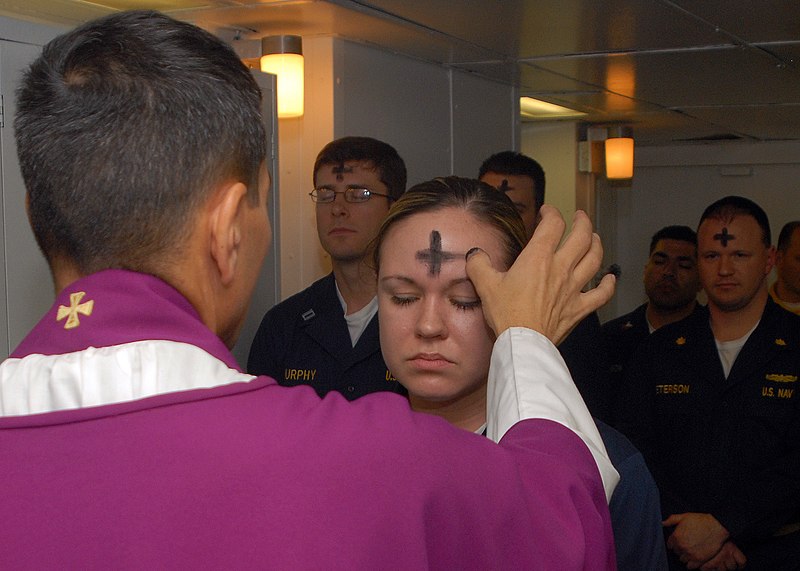How is it that something so Biblical and so well established in evangelical catholic practice over the ages might be missing from Lutheran congregations? I can only posit one reason -- fear of things Katholische.
The prophet Jeremiah, for example, calls for repentance this way:
"O daughter of my people, gird on sackcloth, roll in the ashes"
(Jer 6:26). The prophet Isaiah, on the other hand, critiques the use of sackcloth and
ashes as inadequate to please God, but in the process he indicates that this practice was
well-known in Israel: "Is this the manner of fasting I wish, of keeping a day of penance:
that a man bow his head like a reed, and lie in sackcloth and ashes? Do you call this a
fast, a day acceptable to the Lord?"
(Is 58:5).
The prophet Daniel pleaded for God to rescue Israel with sackcloth and ashes
as a sign of Israel's repentance: "I turned to the Lord God, pleading in earnest prayer,
with fasting, sackcloth and ashes" (Dn 9:3). Perhaps the best known example of repentance in the Old Testament also involves
sackcloth and ashes. When the prophet Jonah finally obeyed God's command and preached in
the great city of Nineveh, his preaching was amazingly effective. Word of his message was
carried to the king of Nineveh. "When the news reached the king of Nineveh, he rose from
his throne, laid aside his robe, covered himself with sackcloth, and sat in the ashes" (Jon
3:6).
Prior to the New Testament period, the rebels fighting for Jewish independence,
the Maccabees, prepared for battle using ashes: "That day they fasted and wore sackcloth;
they sprinkled ashes on their heads and tore their clothes" (1 Mc 3:47; see also 4:39). In the New Testament, Jesus refers to the use of sackcloth and ashes as signs
of repentance: "Woe to you, Chorazin! Woe to you, Bethsaida! For if the mighty deeds done
in your midst had been done in Tyre and Sidon, they would long ago have repented in sackcloth
and ashes" (Mt 11:21, Lk 10:13).
Thomas Talley, an expert
on the history of the liturgical year, says that the first clearly datable liturgy for
Ash Wednesday that provides for sprinkling ashes is in the Romano-Germanic pontifical of
960. Before that time, ashes had been used as a sign of admission to the Order of Penitents.
As early as the sixth century, the Spanish Mozarabic rite calls for signing the forehead
with ashes when admitting a gravely ill person to the Order of Penitents. At the beginning
of the 11th century, Abbot Aelfric notes that it was customary for all the faithful to
take part in a ceremony on the Wednesday before Lent that included the imposition of ashes.
Near the end of that century, Pope Urban II called for the general use of ashes on that
day. Only later did this day come to be called Ash Wednesday.
In the 12th century the rule developed that the ashes were to be created
by burning palm branches from the previous Palm Sunday. Many parishes today invite parishioners
to bring such palms to church before Lent begins and have a ritual burning of the palms
after Mass. All of this, of course, well before the time of Luther.
Ashes in the Church were never seen beyond the penitential connection and never were accorded even a quasi-sacramental status. You would hardly know it, though, since some of the largest crowds
in the year will show up to receive ashes on Ash Wednesday. Though no holy day
of obligation (for Roman Catholics), most would not think of letting Ash Wednesday go
by without a trip to church to be marked with an ashen cross on their foreheads.
Funny how things like Lent and Mardi Gras become detached from their liturgical tradition to take on a life of their own. In a couple of weeks we will again be marked with the sign of the cross and show forth in this outward way the repentant heart inside -- remembering well that the work of repentance is the very work of the Spirit within us and nothing about which we can boast.

3 comments:
It is funny because we used them in my church while I was growing up and it wasn't until I went to college that I found out that not all Lutherans use them. I was really confused because I wasn't sure what Ash Wednesday was without the ashes.
I have never seen a congregation NOT do the imposition of ashes! This post seems foreign to me.
I spent three years in Catholic school and became familiar with ashes, although they never explained to us why they used them. I wasn't active in church at all at that time, so there was no pastor to ask.
When I was confirmed, I asked the pastor at the beginning of Lent if there would be ashes on Ash Wednesday; he snorted and scornfully told me "That's a Catholic thing"
My current congregation has the imposition of ashes and admittedly, that's one of my three favourite services of the year, the other being Tenebrae, followed very closely behind by Easter morning. I can't imagine Ash Wednesday without them now.
Post a Comment